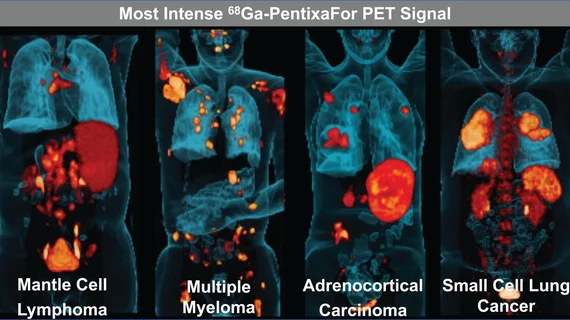New radiotracer IDs numerous cancers likely to respond to targeted therapy
A new radiotracer was recently found capable of identifying numerous cancers on PET imaging that are most likely to respond favorably to certain targeted therapies, according to a recent analysis published in the Journal of Nuclear Medicine.
The radiotracer, 68Ga-PentixaFor, can be used for detecting C-X-C motif chemokine receptor 4 (CXCR4), which plays a significant role in cancer progression. Chemokine receptor expression has been used as a marker for predicting prognosis and is often associated with poor outcomes. Identifying tumors that exhibit CXCR4 expression could help guide clinicians in managing treatment plans by giving them insight into whether their patients would benefit from CXCR4-targeted therapies.
While 68Ga-PentixaFor has been shown to have numerous benefits in PET imaging, it cannot yet be widely adopted due to a lack of suitable data relative to its use, experts involved in the research suggested.
“The beneficial use of 68Ga-Pentixafor PET/CT, along with its potential to identify patients eligible for treatment with β-particle emitters, favors wider clinical use,” corresponding author Andreas Buck of University Hospital Würzburg in Germany and co-authors explained. “However, before widespread adoption or clinical development programs leading to market authorization, comprehensive characterization of its performance should be undertaken, including assessment of radiopharmaceutical uptake and image contrast among a broad spectrum of neoplasms.”
The researchers sought to better understand the radiotracer’s radiopharmaceutical uptake and image contrast in a variety of malignant tumors. To do so, they analyzed the cases of patients with 35 different types of cancer who had cumulatively undergone a total of 777 PET/CT scans with 68Ga-Pentixafor, serving as the CXCR4-specific radioligand.
After excluding exams that did not show recognizable signs of uptake, the experts were left with 535 PET scans to evaluate. On these scans, a noticeable uptake was observed for multiple myeloma (113), adrenocortical carcinoma (30), mantle cell lymphoma (20), adrenocortical adenoma (6) and small cell lung cancer. These findings were similar when assessing image contrast.
These results prompted the authors to suggest that 68Ga-Pentixafor PET/CT could play a pivotal role in determining which patients would response most favorably to CXCR4-targeted therapies in numerous clinical scenarios.
This is a finding that the researchers are planning on continuing to investigate in 2023 in an important phase III study.
The detailed study can be viewed in the Journal of Nuclear Medicine.

